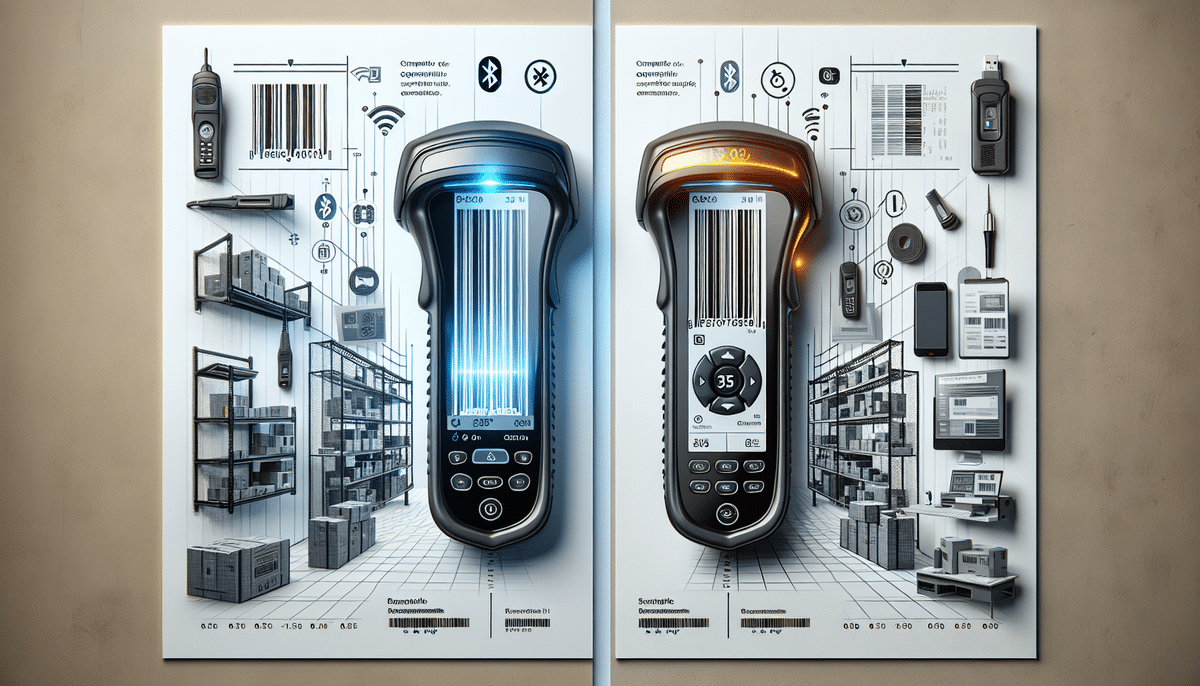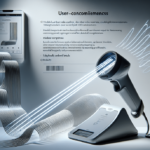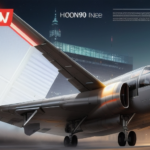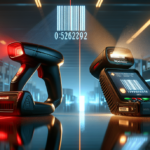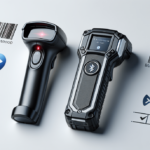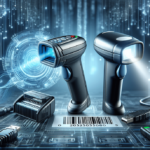Inateck BCST-70 vs WoneNice USB Laser Barcode Scanner
In today's fast-paced business environment, barcode scanners are essential for efficient inventory management, sales processing, and operational accuracy. This comparison focuses on two leading laser barcode scanners: the Inateck BCST-70 and the WoneNice USB Laser Barcode Scanner. Both models are celebrated for their reliability and performance across various industries. This detailed analysis will help you determine which scanner best fits your business needs.
Introduction: The Importance of Barcode Scanners in Modern Business
Barcode scanners are pivotal in streamlining business operations by reducing manual data entry, minimizing errors, and enhancing productivity. They are integral to:
- Inventory management
- Sales reporting
- Order and shipment tracking
- Point-of-sale (POS) transactions
According to a report by Statista, the adoption of barcode scanning technology has significantly increased efficiency in retail and logistics sectors. Selecting the right barcode scanner is crucial for leveraging these benefits effectively and ensuring smooth business operations.
What to Look for in a Barcode Scanner: Key Features to Consider
When choosing a barcode scanner, it's essential to evaluate the following features:
- Type of Scanner: Laser, 2D, CCD, etc.
- Compatibility: Ensure it integrates with your existing systems.
- Connectivity Options: USB, Bluetooth, wireless, etc.
- Price Point: Fits within your budget constraints.
- Performance: Speed, accuracy, and reliability.
- User Interface: Ease of use and navigation.
- Customer Support and Warranty: Availability of post-purchase support.
Evaluating these features ensures that the chosen barcode scanner aligns with your business requirements and operational workflows.
Inateck BCST-70: Overview and Key Features
The Inateck BCST-70 is a versatile barcode scanner designed for both industrial and retail environments. Its key features include:
- Scanning Capabilities: Reads both 1D and 2D barcodes with high accuracy.
- Decoding Rate: Up to 220 scans per second, suitable for high-volume operations.
- Connectivity: Offers USB, Bluetooth, and wireless options for flexible integration.
- Durability: Built to withstand drops from up to 1.8 meters, ensuring longevity in demanding settings.
- Battery Life: Provides up to 30 hours of continuous use on a single charge.
- Advanced Features: Includes motion detection and automatic scanning for enhanced efficiency.
The Inateck BCST-70 features a robust design and user-friendly interface, making it ideal for industries such as retail, healthcare, and logistics where reliability and speed are paramount.
WoneNice USB Laser Barcode Scanner: Overview and Key Features
The WoneNice USB Laser Barcode Scanner is a reliable and efficient device tailored for businesses seeking a straightforward scanning solution. Its standout features include:
- Design: Ergonomic and lightweight, ensuring comfortable use during extended periods.
- Scanning Technology: Laser-based, optimized for reading 1D barcodes accurately.
- Decoding Rate: Capable of up to 100 scans per second, suitable for moderate scanning needs.
- Connectivity: USB connection compatible with Windows, Mac, and Linux systems.
- Durability: Resistant to drops from up to 1.5 meters, ensuring reliability in busy environments.
- Scanning Range: Effective up to 12 inches, ideal for standard retail settings.
The WoneNice USB Laser Barcode Scanner is best suited for retail stores and small to medium-sized businesses where ease of use and affordability are key considerations.
Performance Comparison: Speed, Accuracy, and Reliability
Performance metrics are critical when selecting a barcode scanner, especially for high-demand operations:
- Speed:
- Inateck BCST-70: 220 scans/sec
- WoneNice USB: 100 scans/sec
- Accuracy: Both scanners offer high accuracy with minimal read errors, ensuring reliable data capture.
- Reliability: Both models are dependable for consistent scanning operations, minimizing downtime.
Additionally, the Inateck BCST-70 offers a longer scanning range of up to 35 inches compared to the WoneNice USB scanner’s 20 inches, making it more suitable for scanning items on high shelves or in hard-to-reach areas.
Industry surveys, such as those by Business.com, indicate that scanner speed and accuracy are paramount for maintaining operational efficiency and customer satisfaction.
Compatibility and Connectivity: Which Scanner Works Best with Your System?
Ensuring that your barcode scanner integrates seamlessly with your existing systems is essential for smooth operations:
- Inateck BCST-70: Offers multiple connectivity options including USB, Bluetooth, and wireless, making it highly versatile and compatible with a wide range of devices and operating systems.
- WoneNice USB: Primarily utilizes USB connectivity, ensuring compatibility with Windows, Mac, and Linux systems.
Furthermore, the Inateck BCST-70 supports both 1D and 2D barcode scanning, providing greater flexibility compared to the WoneNice USB scanner, which is limited to 1D barcodes. For businesses requiring diverse barcode scanning capabilities, the Inateck model may offer a more advantageous solution.
Price Point Comparison: Value for Money Assessment
Cost is a significant factor when selecting a barcode scanner, and it's important to balance price with required features:
- Inateck BCST-70: Approximately $80. While more expensive, it offers additional features and connectivity options suitable for industrial use and high-volume operations.
- WoneNice USB: Approximately $30. A budget-friendly option ideal for businesses with lower scanning volumes and simpler needs.
Investing in the Inateck BCST-70 can provide greater long-term value for businesses that demand high performance and versatility, whereas the WoneNice USB scanner is suitable for cost-conscious businesses prioritizing basic functionality.
Customer Support and Warranty Comparison
Post-purchase support and warranty coverage are crucial for ensuring long-term satisfaction and minimizing potential issues:
- Inateck BCST-70: Comes with a two-year warranty and offers excellent customer support, providing peace of mind and assistance in case of any operational issues.
- WoneNice USB: Offers a one-year warranty with limited customer support options, which may suffice for smaller operations with less intensive usage.
Choosing a scanner with robust customer support and comprehensive warranty can mitigate potential risks and enhance the overall user experience.
Conclusion: Which Barcode Scanner is Right for You?
Deciding between the Inateck BCST-70 and the WoneNice USB Laser Barcode Scanner depends on your specific business needs and operational requirements:
- Inateck BCST-70: Best suited for industrial environments requiring a versatile, durable, and high-performance scanner with advanced features and multiple connectivity options.
- WoneNice USB: Ideal for businesses with basic scanning needs or those operating on a limited budget, offering reliable performance at an affordable price.
Assess your operational requirements, budget, and desired features carefully to select the barcode scanner that best aligns with your business objectives.
Other Top Barcode Scanners on the Market Today
Besides the Inateck BCST-70 and WoneNice USB Laser Barcode Scanner, here are other top-rated barcode scanners that offer unique features tailored to different business needs:
- Zebra DS9208 Barcode Scanner: Known for its high-performance scanning and ergonomic design.
- Honeywell Voyager 1250g: Offers fast and accurate 1D barcode scanning with wireless capabilities.
- NADAMOO Wireless Barcode Scanner: Features wireless connectivity and a robust build for diverse environments.
Each of these scanners brings distinct advantages, making them suitable for various applications across different industries.
How do Laser Barcode Scanners Work?
A laser barcode scanner operates by emitting a laser beam that travels across the barcode. The barcode's varying reflectivity allows the scanner's sensor to detect the pattern of bars and spaces, which is then decoded into readable information for the system. This process enables quick and accurate data capture, essential for efficient inventory and sales management.
Advantages of Using a Laser Barcode Scanner over Other Types of Scanners
Laser barcode scanners offer several advantages compared to other types:
- Speed: Capable of reading barcodes rapidly, enhancing productivity in high-volume environments.
- Accuracy: Provides precise scanning with minimal errors, ensuring reliable data capture.
- Range: Can read barcodes from a distance, beneficial for scanning items in hard-to-reach areas.
These features make laser barcode scanners particularly effective for businesses where efficiency and reliability are critical to operations.
Applications of Laser Barcode Scanners in Different Industries
Laser barcode scanners are utilized across various industries, including:
- Manufacturing: For tracking inventory and managing supply chains efficiently.
- Healthcare: For managing patient records, medication inventories, and equipment tracking.
- Retail: For seamless POS transactions, inventory management, and customer service enhancement.
- Logistics: For tracking shipments, managing warehouse operations, and ensuring timely deliveries.
In each of these sectors, laser barcode scanners contribute to streamlined operations, reduced errors, and improved overall efficiency.
How to Use a Barcode Scanner Properly
To ensure optimal performance and longevity of your barcode scanner, follow these best practices:
- Positioning: Place the barcode within the scanner's effective range, typically within a few inches.
- Alignment: Align the barcode accurately with the scanner's laser beam for precise reading.
- Activation: Press the scan button or trigger to emit the laser beam and initiate scanning.
- Scanning: Hold the scanner steady until the barcode is captured and decoded successfully.
- Verification: Ensure the scanned information is correctly displayed on your system or device.
- Maintenance: Regularly clean the scanner's lens and update its firmware to maintain optimal performance.
Proper usage and routine maintenance are essential for maximizing the efficiency and lifespan of your barcode scanner, ensuring consistent performance and reliability.
Future Trends in Barcode Scanning Technology
The barcode scanning industry is continually evolving with advancements aimed at increasing efficiency and expanding functionality:
- Integration with IoT: Enhanced barcode scanners are being integrated with Internet of Things (IoT) devices for real-time data analytics and monitoring.
- Mobile Scanning: The rise of mobile-based scanners allows for greater flexibility and mobility in various business operations.
- AI and Machine Learning: Incorporating AI to improve scanning accuracy and predictive maintenance capabilities.
- Enhanced Security Features: Advanced encryption and secure data transmission are becoming standard to protect sensitive information.
Staying updated with these trends can help businesses adopt the latest technologies that enhance operational efficiency and competitiveness.















